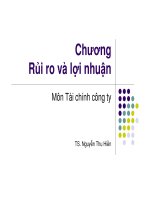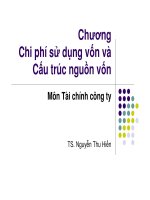Bài giảng tài chính công MNC
Bạn đang xem bản rút gọn của tài liệu. Xem và tải ngay bản đầy đủ của tài liệu tại đây (1.06 MB, 17 trang )
Bài tập nhóm
MNCs
Trình bày: VCF
65.000 pound
390.000
pound, tăng
trưởng 5%/
năm
225.000 pound
Dorchest
er
290.00
0
Các mức tỷ giá kỳ vọng
Năm thứ
thứ tư
Năm
ba
hai
nhất
năm
Dòng tiền thuần từ hoạt động kinh
doanh
Lá chắn thuế khấu hao
Huy động vốn cho dự án
Số vốn cần huy động là 2,000,000£ (tương
đương 3,000,000$). Trong đó 1,500,000$ được
vay tại chính quyền địa phương với lãi suất
7.75%/ năm. Khoản 1,000,000£ còn lại sẽ được
vay bằng cách phát hành trái phiếu trong nước
hay phát hành trái phiếu Eurodollar sẽ tùy thuộc
vào việc tính toán lãi suất thực của 2 khoản vay
này.
Thanh toán nợ vay
Các thành phần khác
Nếu không tính đến giá trị thanh lý
Kết luận
Quan điểm của nhóm
Dorchester Ltd., is an old-line confectioner specializing in high-quality chocolates. Through its facilities in the United Kingdom,
Dorchester manufactures candies that it sells throughout Western Europe and North America (United States and Canada). With its
current manufacturing facilities, Dorchester has been unable to supply the U.S. market with more than 225,000 pounds of candy per year.
This supply has allowed its sales affiliate, located in Boston, to be able to penetrate the U.S. market no farther west than St. Louis and
only as far south as Atlanta. Dorchester believes that a separate manufacturing facility located in the United States would allow it to
supply the entire U.S. market and Canada (which presently accounts for 65,000 pounds per year). Dorchester currently estimates initial
demand in the North American market at 390,000 pounds, with growth at a 5 percent annual rate. A separate manufacturing facility
would, obviously, free up the amount currently shipped to the United States and Canada. But Dorchester believes that this is only a
short-run problem. They believe the economic development taking place in Eastern Europe will allow it to sell there the full amount
presently shipped to North America within a period of five years.
Dorchester presently realizes £3.00 per pound on its North American exports. Once the U.S. manufacturing facility is operating,
Dorchester expects that it will be able to initially price its product at $7.70 per pound. This price would represent an operating profit of
$4.40 per pound. Both sales price and operating costs are expected to keep track with the U.S. price level; U.S. inflation is forecast at a
rate of 3 percent for the next several years. In the U.K., long-run inflation is expected to be in the 4 to 5 percent range, depending on
which economic service one follows. The current spot exchange rate is $1.50/£1.00. Dorchester explicitly believes in PPP as the best
means to forecast future exchange rates.
The manufacturing facility is expected to cost $7,000,000. Dorchester plans to finance this amount by a combination of equity
capital and debt. The plant will increase Dorchester’s borrowing capacity by £2,000,000, and it plans to borrow only that amount. The
local community in which Dorchester has decided to build will provide $1,500,000 of debt financing for a period of seven years at 7.75
percent. The principal is to be repaid in equal installments over the life of the loan. At this point, Dorchester is uncertain whether to raise
the remaining debt it desires through adomestic bond issue or a Eurodollar bond issue. It believes it can borrow pounds sterling at 10.75
percent per annum and dollars at 9.5 percent. Dorchester estimates its all-equity cost of capital to be 15 percent.
The U.S. Internal Revenue Service will allow Dorchester to depreciate the new facility over a seven-year period. After that time
the confectionery equipment, which accounts for the bulk of the investment, is expected to have substantial market value. Dorchester
does not expect to receive any special tax concessions. Further, because the corporate tax rates in the two countries are the same--35
percent in the U.K. and in the United States--transfer pricing strategies are ruled out.
Dorchester presently realizes £3.00 per pound on its
North American exports.
Should Dorchester build the new manufacturing plant in the United States?
Capital Budgeting from the Parent
Firm’s Perspective
T
APV =
Σ
t=1
+
StOCFt(1 – τ)
(1 + Kud)
St TVT
t
T
+
T
St τ Dt
S t τ It
Σ (1 + i ) +Σ (1 + i )
t=1
d
t
t=1
– S0C0 + S0RF0 + S0CL0 -
d
T
t
Σ
St LPt
t
(1 + Kud)
t = 1 (1 + id)
The operating cash flows must
The operating cash flows
be translated back into the
parent firm’s currency at the
must be discounted at the
spot rate expected to prevail
unlevered domestic rate
in each period.
18-15
T
Capital Budgeting from the Parent
Firm’s Perspective
T
APV =
Σ
t=1
+
StOCFt(1 – τ)
(1 + Kud)
St TVT
(1 + Kud)
T
t
T
+
St τ Dt
S t τ It
Σ (1 + i ) +Σ (1 + i )
t=1
d
t
t=1
– S0C0 + S0RF0 + S0CL0 -
OCFt represents only the
portion of operating cash flows
available for remittance that
can be legally remitted to the
parent firm.
18-16
T
d
t
T
Σ (1 + i )
t=1
St LPt
d
t
The marginal corporate tax
rate, τ, is the larger of the
parent’s or foreign
subsidiary’s.
Capital Budgeting from the Parent
Firm’s Perspective
T
APV =
Σ
t=1
+
StOCFt(1 – τ)
(1 + Kud)
St TVT
(1 + Kud)
T
t
T
+
St τ Dt
S t τ It
Σ (1 + i ) +Σ (1 + i )
t=1
d
t
t=1
– S0C0 + S0RF0 + S0CL0 -
S0RF0 represents the value of
accumulated restricted funds
(in the amount of RF0) that are
freed up by the project.
18-17
T
d
t
T
Σ (1 + i )
t=1
St LPt
d
t
Denotes the present value
(in the parent’s currency)
of any concessionary
loans, CL0, and loan
payments, LPt , discounted
at id .









